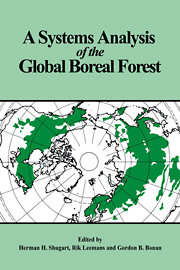Book contents
- Frontmatter
- Contents
- List of contributors
- 1 Introduction
- Part 1 Processes in boreal forests
- Part 2 Patterns in space and time in boreal forests
- Part 3 Computer models for synthesis of pattern and process in the boreal forest
- Introduction
- 12 Individual-tree-based models of forest dynamics and their application in global change research
- 13 Population-level models of forest dynamics
- 14 A spatial model of long-term forest fire dynamics and its applications to forests in western Siberia
- 15 A simulation analysis of environmental factors and ecological processes in North American boreal forests
- 16 The biological component of the simulation model for boreal forest dynamics
- 17 Role of stand simulation in modeling forest response to environmental change and management interventions
- 18 Concluding comments
- References
- Index
17 - Role of stand simulation in modeling forest response to environmental change and management interventions
Published online by Cambridge University Press: 12 January 2010
- Frontmatter
- Contents
- List of contributors
- 1 Introduction
- Part 1 Processes in boreal forests
- Part 2 Patterns in space and time in boreal forests
- Part 3 Computer models for synthesis of pattern and process in the boreal forest
- Introduction
- 12 Individual-tree-based models of forest dynamics and their application in global change research
- 13 Population-level models of forest dynamics
- 14 A spatial model of long-term forest fire dynamics and its applications to forests in western Siberia
- 15 A simulation analysis of environmental factors and ecological processes in North American boreal forests
- 16 The biological component of the simulation model for boreal forest dynamics
- 17 Role of stand simulation in modeling forest response to environmental change and management interventions
- 18 Concluding comments
- References
- Index
Summary
Introduction
Strong advances in understanding forest ecology and forest-ecosystem responses to disturbance and environmental change have come through the application of systems analysis and simulation in studies of small forested ecosystems. For example, the whole series of gap models of forest succession (e.g. JABOWA (Botkin, Janak & Wallis 1972), FORET (Shugart & West 1977), FORTNITE (Aber & Melillo 1982), LINKAGES (Pastor & Post 1985), FORENA (Solomon 1986) and FORSKA (Leemans 1989); see Shugart (1984) for an overview of several of these models) examines forest ecosystems at the spatial scale of one or several large trees, i.e. about 0.1 ha. These models represent areas of sufficient spatial extent to represent adequately important processes such as inter- and intra-specific competition, and soil–vegetation–atmosphere interactions. Results from such models might reasonably be scaled up spatially to the level of the stand, where stand is defined as an ecosystem with a relatively homogenous community of trees and relatively homogenous site conditions compared with neighboring ecosystems. However, generalization of results from stand-level models (as the gap and other microcosm models will now be called) to forest ecosystems containing many stands, without the use of specially formulated forest simulation models, can be dangerous, if not absolutely misleading.
Ecologists generally recognize that ecosystem boundaries are more or less arbitrary. Some such boundaries are easy to assign and are ecologically very meaningful, such as the perimeter of an island in a lake, or the perimeter of a farm woodlot surrounded by field crops.
- Type
- Chapter
- Information
- A Systems Analysis of the Global Boreal Forest , pp. 446 - 465Publisher: Cambridge University PressPrint publication year: 1992
- 3
- Cited by



